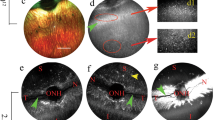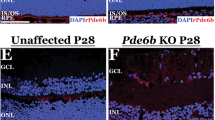Abstract
Previous studies have tested gene replacement therapy in RPE65-deficient dogs using recombinant adeno-associated virus 2/2 (rAAV2/2), -2/1 or -2/5 mediated delivery of the RPE65 gene. They all documented restoration of dark- and light-adapted electroretinography responses and improved psychophysical outcomes. Use of a specific RPE65 promoter and a rAAV vector that targets transgene expression specifically to the RPE may, however, provide a safer setting for the long-term therapeutic expression of RPE65. Subretinal injection of rAAV2 pseudotyped with serotype 4 (rAAV2/4) specifically targets the RPE. The purpose of our study was to evaluate a rAAV2/4 vector carrying a human RPE65cDNA driven by a human RPE65 promoter, for the ability to restore vision in RPE65−/− purebred Briard dogs and to assess the safety of gene transfer with respect to retinal morphology and function. rAAV2/4 and rAAV2/2 vectors containing similar human RPE65 promoter and cDNA cassettes were generated and administered subretinally in eight affected dogs, ages 8–30 months (n=6 with rAAV2/4, n=2 with rAAV2/2). Although fluorescein angiography and optical coherence tomography examinations displayed retinal abnormalities in treated retinas, electrophysiological analysis demonstrated that restoration of rod and cone photoreceptor function started as soon as 15 days post-injection, reaching maximal function at 3 months post-injection, and remaining stable thereafter in all animals treated at 8–11 months of age. As assessed by the ability of these animals to avoid obstacles in both dim and normal light, functional vision was restored in the treated eye, whereas the untreated contralateral eye served as an internal control. The dog treated at a later age (30 months) did not recover retinal function or vision, suggesting that there might be a therapeutic window for the successful treatment of RPE65−/− dogs by gene replacement therapy.
This is a preview of subscription content, access via your institution
Access options
Subscribe to this journal
Receive 12 print issues and online access
$259.00 per year
only $21.58 per issue
Buy this article
- Purchase on Springer Link
- Instant access to full article PDF
Prices may be subject to local taxes which are calculated during checkout






Similar content being viewed by others

References
Kaplan J, Bonneau D, Frezal J, Munnich A, Dufier JL . Clinical and genetic heterogeneity in retinitis pigmentosa. Hum Genet 1990; 85: 635–642.
Koenekoop RK . An overview of Leber congenital amaurosis: a model to understand human retinal development. Surv Ophthalmol 2004; 49: 379–398.
Hanein S, Perrault I, Gerber S, Tanguy G, Barbet F, Ducroq D et al. Leber congenital amaurosis: comprehensive survey of the genetic heterogeneity, refinement of the clinical definition, and genotype-phenotype correlations as a strategy for molecular diagnosis. Hum Mutat 2004; 23: 306–317.
Perrault I, Hanein S, Gerber S, Barbet F, Ducroq D, Dollfus H et al. Retinal dehydrogenase 12 (RDH12) mutations in Leber congenital amaurosis. Am J Hum Genet 2004; 75: 639–646.
Auricchio A, Rolling F . Adeno-associated viral vectors for retinal gene transfer and treatment of retinal diseases. Curr Gene Ther 2005; 5: 339–348.
Choi VW, McCarty DM, Samulski RJ . AAV hybrid serotypes: improved vectors for gene delivery. Curr Gene Ther 2005; 5: 299–310.
Gao G, Vandenberghe LH, Wilson JM . New recombinant serotypes of AAV vectors. Curr Gene Ther 2005; 5: 285–297.
Hamel CP, Tsilou E, Pfeffer BA, Hooks JJ, Detrick B, Redmond TM . Molecular cloning and expression of RPE65, a novel retinal pigment epithelium-specific microsomal protein that is post-transcriptionally regulated in vitro. J Biol Chem 1993; 268: 15751–15757.
Bavik CO, Busch C, Eriksson U . Characterization of a plasma retinol-binding protein membrane receptor expressed in the retinal pigment epithelium. J Biol Chem 1992; 267: 23035–23042.
Thompson DA, Gal A . Vitamin A metabolism in the retinal pigment epithelium: genes, mutations, and diseases. Prog Retin Eye Res 2003; 22: 683–703.
Jin M, Li S, Moghrabi WN, Sun H, Travis GH . Rpe65 is the retinoid isomerase in bovine retinal pigment epithelium. Cell 2005; 122: 449–459.
Moiseyev G, Chen Y, Takahashi Y, Wu BX, Ma JX . RPE65 is the isomerohydrolase in the retinoid visual cycle. Proc Natl Acad Sci USA 2005; 102: 12413–12418.
Marlhens F, Bareil C, Griffoin JM, Zrenner E, Amalric P, Eliaou C et al. Mutations in RPE65 cause Leber's congenital amaurosis. Nat Genet 1997; 17: 139–141.
Gu SM, Thompson DA, Srikumari CR, Lorenz B, Finckh U, Nicoletti A et al. Mutations in RPE65 cause autosomal recessive childhood-onset severe retinal dystrophy. Nat Genet 1997; 17: 194–197.
Lorenz B, Gyurus P, Preising M, Bremser D, Gu S, Andrassi M et al. Early-onset severe rod-cone dystrophy in young children with RPE65 mutations. Invest Ophthalmol Vis Sci 2000; 41: 2735–2742.
Aguirre GD, Baldwin V, Pearce-Kelling S, Narfstrom K, Ray K, Acland GM . Congenital stationary night blindness in the dog: common mutation in the RPE65 gene indicates founder effect. Mol Vis 1998; 4: 23.
Veske A, Nilsson SE, Narfstrom K, Gal A . Retinal dystrophy of Swedish Briard/Briard-beagle dogs is due to a 4-bp deletion in RPE65. Genomics 1999; 57: 57–61.
Acland GM, Aguirre GD, Ray J, Zhang Q, Aleman TS, Cideciyan AV et al. Gene therapy restores vision in a canine model of childhood blindness. Nat Genet 2001; 28: 92–95.
Acland GM, Aguirre GD, Bennett J, Aleman TS, Cideciyan AV, Bennicelli J et al. Long-term restoration of rod and cone vision by single dose rAAV-mediated gene transfer to the retina in a canine model of childhood blindness. Mol Ther 2005; 12: 1072–1082.
Narfstrom K, Katz ML, Bragadottir R, Seeliger M, Boulanger A, Redmond TM et al. Functional and structural recovery of the retina after gene therapy in the RPE65 null mutation dog. Invest Ophthalmol Vis Sci 2003; 44: 1663–1672.
Narfstrom K, Vaegan, Katz M, Bragadottir R, Rakoczy EP, Seeliger M . Assessment of structure and function over a 3-year period after gene transfer in RPE65−/− dogs. Doc Ophthalmol 2005; 111: 39–48.
Weber M, Rabinowitz J, Provost N, Conrath H, Folliot S, Briot D et al. Recombinant adeno-associated virus serotype 4 mediates unique and exclusive long-term transduction of retinal pigmented epithelium in rat, dog, and nonhuman primate after subretinal delivery. Mol Ther 2003; 7: 774–781.
Le Meur G, Weber M, Pereon Y, Mendes-Madeira A, Nivard D, Deschamps JY et al. Postsurgical assessment and long-term safety of recombinant adeno-associated virus-mediated gene transfer into the retinas of dogs and primates. Arch Ophthalmol 2005; 123: 500–506.
Huang D, Swanson EA, Lin CP, Schuman JS, Stinson WG, Chang W et al. Optical coherence tomography. Science 1991; 254: 1178–1181.
Fujimoto JG, Brezinski ME, Tearney GJ, Boppart SA, Bouma B, Hee MR et al. Optical biopsy and imaging using optical coherence tomography. Nat Med 1995; 1: 970–972.
Holopigian K, Seiple W, Greenstein VC, Hood DC, Carr RE . Local cone and rod system function in progressive cone dystrophy. Invest Ophthalmol Vis Sci 2002; 43: 2364–2373.
Stieger K, Le Meur G, Lasne F, Weber M, Deschamps JY, Nivard D et al. Long-term doxycycline-regulated transgene expression in the retina of nonhuman primates following subretinal injection of recombinant AAV vectors. Mol Ther 2006; 13: 967–975.
Pang JJ, Chang B, Kumar A, Nusinowitz S, Noorwez SM, Li J et al. Gene therapy restores vision-dependent behavior as well as retinal structure and function in a mouse model of RPE65 Leber congenital amaurosis. Mol Ther 2005; 10: 10.
Woodruff ML, Wang Z, Chung HY, Redmond TM, Fain GL, Lem J . Spontaneous activity of opsin apoprotein is a cause of Leber congenital amaurosis. Nat Genet 2003; 35: 158–164.
Zhang X, De Alwis M, Hart SL, Fitzke FW, Inglis SC, Boursnell ME et al. High-titer recombinant adeno-associated virus production from replicating amplicons and herpes vectors deleted for glycoprotein H. Hum Gene Ther 1999; 10: 2527–2537.
Rabinowitz JE, Rolling F, Li C, Conrath H, Xiao W, Xiao X et al. Cross-packaging of a single adeno-associated virus (AAV) type 2 vector genome into multiple AAV serotypes enables transduction with broad specificity. J Virol 2002; 76: 791–801.
Gao GP, Qu G, Faust LZ, Engdahl RK, Xiao W, Hughes JV et al. High-titer adeno-associated viral vectors from a Rep/Cap cell line and hybrid shuttle virus. Hum Gene Ther 1998; 9: 2353–2362.
Salvetti A, Oreve S, Chadeuf G, Favre D, Cherel Y, Champion-Arnaud P et al. Factors influencing recombinant adeno-associated virus production. Hum Gene Ther 1998; 9: 695–706.
Marmor MF, Zrenner E . Standard for clinical electroretinography (1999 update). International Society for Clinical Electrophysiology of Vision. Doc Ophthalmol 1998; 97: 143–156.
Acknowledgements
We thank Matthew Ellinwood for critical reading and editing. We also thank the Vector Core (www.vectors.nantes.inserm.fr) at the University Hospital of Nantes, supported by the Association Française contre les Myopathies (AFM), INSERM and the Fondation pour la Thérapie Génique en Pays de la Loire. This work was also supported by the French Lions Club and the Lions Clubs International foundation (LCIF). We thank the Association du Berger de Brie and the Fédération des Aveugles et Handicapés Visuels de France. We also thank Graham Holder and Chris Hogg for assistance with the ERG.
Author information
Authors and Affiliations
Corresponding author
Additional information
Supplementary Information accompanies the paper on Gene Therapy website (http://www.nature.com/gt)
Supplementary information
Rights and permissions
About this article
Cite this article
Le Meur, G., Stieger, K., Smith, A. et al. Restoration of vision in RPE65-deficient Briard dogs using an AAV serotype 4 vector that specifically targets the retinal pigmented epithelium. Gene Ther 14, 292–303 (2007). https://doi.org/10.1038/sj.gt.3302861
Received:
Revised:
Accepted:
Published:
Issue Date:
DOI: https://doi.org/10.1038/sj.gt.3302861


